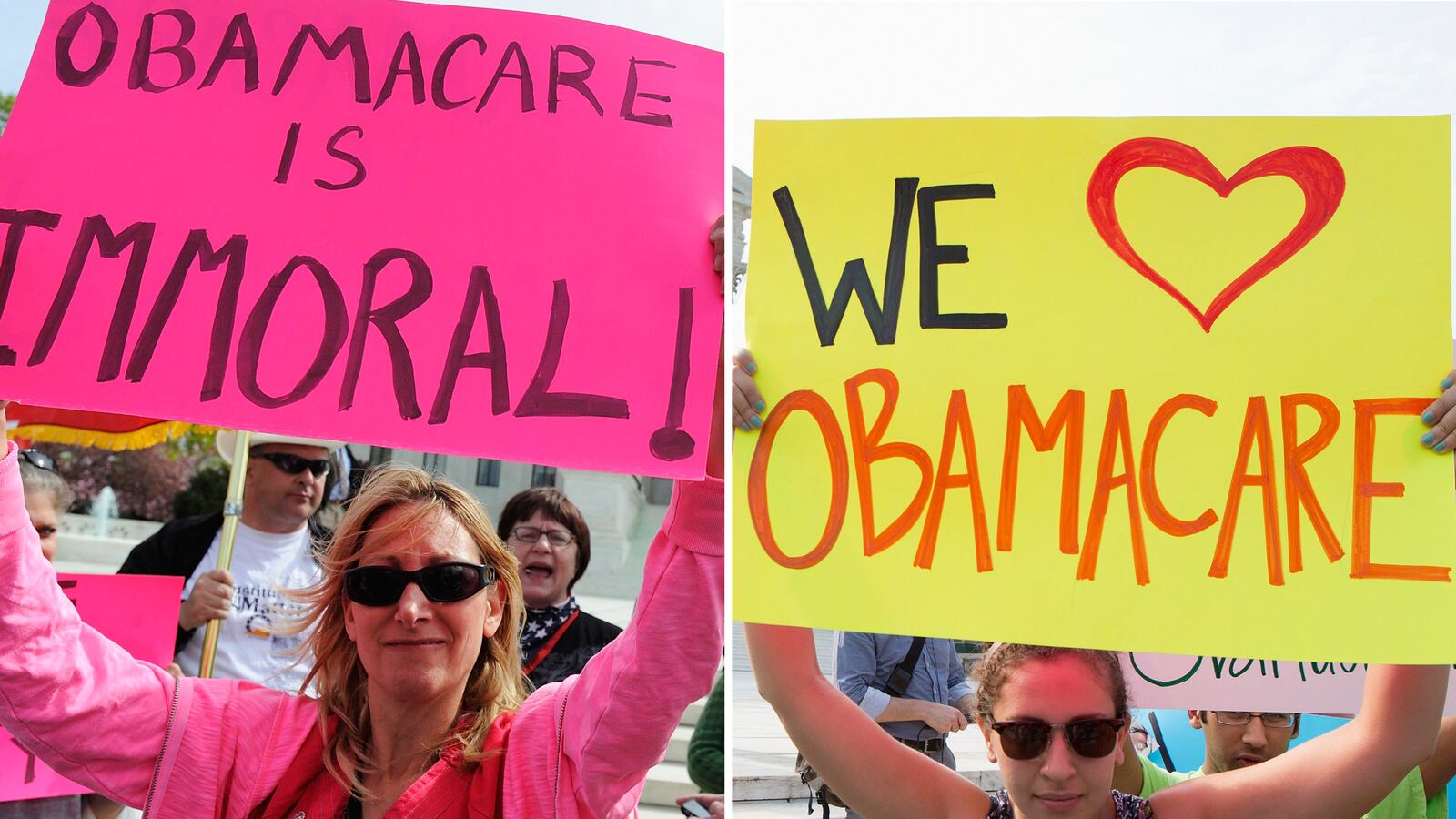In less than a week, the largest piece of social legislation since the 1960s goes live when health-care exchanges set up by the Affordable Care Act open for business. The day will mark the near conclusion of a nearly five-year-long struggle over the measure, one that has seen the birth of the Tea Party, precipitated a shift in power in Congress, and forced the Supreme Court, ultimately, to weigh in.

But even as Republicans in the House and Senate make their last-ditch efforts to scuttle the law, Obamacare is a mostly settled issue. In a number of states, mostly GOP-leaning ones, governors and legislatures are all but refusing to participate, declining to set up their own exchanges—and forcing the federal government, instead, to pick up the slack. Further, many won’t accept an expansion of Medicaid, a central component of the ACA and one that would, in theory, provide health insurance to millions more low-income Americans.
Originally, the federal government had pledged to pick up the tab for 100 percent of all of the expansion of Medicaid for the first three years of Obamacare, and gradually ratchet downward until 90 percent of Medicaid is paid for by the federal government in 2020. But some states saw even a slight increase in their Medicaid numbers as too much—and the Supreme Court ruled that the federal government could not compel states to accept the expansion. Twenty-two declined the federal money; 24 accepted.There are four, however, where the battle is still going on. They are, unsurprisingly, purple states. Are they the last stragglers in war that’s already over? The states that can’t decide? Or a microcosm of the debate that has consumed the nation and a harbinger of what is to come?
“It is a battle within the Republican Party,” said Robert Blendon, a professor of health policy at Harvard’s Kennedy School of Government. “Essentially, the Supreme Court decision left political leaders who really didn’t like this bill with only one option to show they didn’t like the bill, and that was not to expand Medicaid. That decision has consequences of hundreds of millions of dollars, so what you have is a combination of governors and legislators over whether or not they should keep the line drawn where it is. It is those who are more ideological versus those who are pragmatic.”We tell the story of those four states below:
New Hampshire
Granite State Gov. Maggie Hassan is pushing for the expansion, but Republicans in the legislature have balked, and are resisting efforts to call for a special fall session to vote specifically on the matter. The state established a commission to look into a possible expansion and it is expected to report back next month. With the GOP in charge of the New Hampshire Senate, Democrats and advocates for the poor are not hopeful. “For every day that we delay expansion beyond January 1,” Hassan recently told the Nashua Rotary West Club, “even conservative projections show that New Hampshire stands to lose $500,000 per day in the first year, and up to $1 million per day by 2016.”
Ohio
John Kasich pushed the state rightward in the first few years of his governorship, repealing the estate tax and pushing for a rollback of collective-bargaining rights. He has since edged closer to the center, angering one-time Tea Party allies. He’s pushing for a Medicaid expansion, saying the measure “makes great sense for the state of Ohio because it will allow us to provide greater care with our own dollars” and calling it “a matter of life and death.” In the Buckeye State, too, a Republican-dominated legislature has rebuffed the governor’s efforts. But it was recently reported that Kasich may turn to the Ohio Controlling Board, an obscure oversight panel that can approve contracts and has some final say over the budget, for a lifeline.
Tennessee
Bill Haslam, the Republican governor of the Volunteer State, announced in the spring that he would not accept a Medicaid expansion, but would instead apply for a waiver that would allow the state to expand its existing Medicaid program. So far, though, he has not applied for that waiver. The health-care industry is a big driver of the Tennessee economy: according to close observers of state politics, the governor is torn between industry execs and businesspeople who write big checks, and the Tea Party partisans who vote in primaries. The former want the waiver and the dollars it will bring to the state; the latter don’t want Haslam to touch anything that has to do with Obamacare. The governor has successfully pleased both, however, by blaming the Obama administration for inflexibility. When The Daily Beast inquired about where things stood in Tennessee at this point, the governor’s office sent along a statement from March, which read in part, “All we’re asking from Washington is to allow us to use the federal funds to provide coverage on the health-care exchange in the same way many other Tennesseans will access coverage regardless of whether or not we expand. It’s a reasonable ask.”
Indiana
The Hoosier State is a bit like Tennessee, a deeply red state that will occasionally back Democrats. It’s also done some similar foot-dragging on expanding Medicaid. Instead, Indiana’s existing plan to provide health-care access to the poor, the Healthy Indiana Plan (or HIP), will expand, but not to the point where it will reach as many people as the federal government’s proposal would. The state will revisit the issue in one year. “It’s better than nothing, and I absolutely applaud that they kept HIP so we don’t have 37,000 uninsured,” David Roos, executive director of Covering Kids and Families of Indiana, told The Washington Post. “We’re surrounded by states that have found a better way to do it. I wish they would have gone with a more plain-vanilla expansion.”





